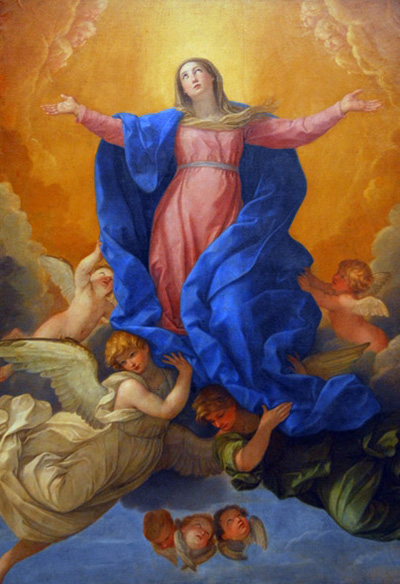
Clothed with the sun
Monday, August 7, 2017
*Rogelio Zelada
Like unexpected thunder, the voice splintered the great rock at the top of the cave that sheltered the prophet, captive on the Isle of Patmos. A celestial trumpet, an imperious voice of God, entered John’s core, shaking him with terrible, urgent visions: "I am the Alpha and the Omega ... the Lord of the Universe."
The celestial images and locutions flood the pages that the seer writes on an improvised stone desk when, suddenly, he sees the great sanctuary of God opening in the heavens and within it, shining, the Ark of the Covenant of God. In this grandiose setting, he contemplates "a woman clothed with the sun, with the moon under her feet, and on her head a crown of 12 stars."

Photographer: Wikimedia Commons
The Assumption of Mary: Guido Reni, 1642
The verbal form that the author uses suggests not the act of seeing but a gaze that, from faith, allows him to move beyond the limits of history. The Ark of the Covenant contained three things: the two tablets of the Law, an evocation of the whole prowess of the Exodus and of the pact of the Covenant; the staff of Moses, that manifested the God of Israel’s protection for his people; and the manna, remembrance of God’s providence and his generosity as dispenser of life.
However, when Jerusalem and the Temple were destroyed in 587 BC, all the sacred furnishings of the Temple burned in the great fire. Thanks to Cyrus, King of the Persians, the Israelites could return from exile and rebuild the city, but the Holy of Holies, the holiest place of the faith of Israel, remained empty because there was nothing left to deposit in it. Then, in reflecting on history, the Jewish mystics sensed that since God could not abandon the Ark, sacred symbol of the Covenant, he had saved it by taking it to heaven. Someday, the sky would open and the Ark would be visible again, as a glorification of the Covenant. This is the image that opens the way in chapter 12 of the Apocalypse, as evocation and fulfillment of this tremendous hope of Israel.
This extraordinary vision gathered in the Book of Revelation has resulted in rich interpretations. For the Fathers of the Church of the first centuries, the celestial image was the sign of the Church, which encompassed both the Old and the New Testament, the community of believers, or also the Virgin Mary, from which the new humanity is born. Like the new Eve, Mary is also the "Daughter of Zion," the chosen one of the Father who appears elevated atop the moon and with the sun as dazzling aura.
The two luminaries created by God at the beginning of Genesis to mark the days and the times of rest are summoned to the great feast of the triumph of the Faith to which we are all called. The sun covers her and the moon serves as her base; 12 stars — 12 tribes, 12 apostles — reaffirm the sense of wholeness that crowns the Church and the Mother of God.
For the scholastic doctors this vision of the Woman of the Apocalypse, along with many other quotations from the Old and the New Testament, foreshadowed the Assumption of Mary into Heaven. In solemnly defining the Dogma of the Assumption with the Constitution Munificentissimus Deus, Pius XII affirmed that this Marian privilege “is in wonderful accord with those divine truths given us in Holy Scripture.” To base their conviction on the Assumption as a common doctrine of the faith, “all these proofs and considerations of the holy Fathers and the theologians are based upon the Sacred Writings as their ultimate foundation.”
The Eastern Church celebrated, especially since the sixth century, the feast of the Dormition of the Mother of God, a feast that the Emperor Mauritius extended to the entire Christian world. The liturgical texts then employed celebrated more than her transit from earthly life, her glorification, transformation and elevation, body and soul, to heaven. In the Eastern Church, the common belief is that death did not touch Mary, but that she was carried asleep in body and soul to the heavens. In contrast, Western theologians recognize the need for death in order to reach the resurrection. In defining the dogma of the Assumption, Pope Pius XII overcame that controversy by asserting that Mary, “having completed the course of her earthly life, was assumed body and soul into heavenly glory.” He thus left future theologians the freedom to investigate and explain this final transit of the Immaculate Virgin.
The Assumption of the Blessed Virgin to the heavens celebrates the total glorification of the body and soul of the Mother of God. What for us is still a promise is for her a reality. A reality fulfilled in advance in her whole being, which the righteous will enjoy on the final day because she reached the whole potential of the fullness of human existence, gloriously and completely transformed in Heaven, an existence that the saints and the blessed do not yet possess. This dogmatic definition was one of the great issues that remained pending at the interruption of the First Vatican Council, when Garibaldi and his troops occupied the Eternal City.
In 1949, Pius XII consulted with all the bishops of the Church on the appropriateness of the dogmatic definition of this doctrine. By the following year 1,169 bishops had responded affirmatively, along with 32,000 priests, 50,000 religious and eight million laity.
On Nov. 1, 1950, feast of All Saints, Pope Pius XII solemnly defined the doctrine of the Assumption of Mary as divinely revealed dogma, of fide catholica, that is, a unique and characteristic element of the faith of the Church.
In his catechesis on the Assumption, St. John Paul II said, "In the Assumption of the Blessed Virgin we can also see the divine will to advance woman… Thus in heavenly glory, beside the risen Christ, there is a woman who has been raised up, Mary: the new Adam and the new Eve, the first fruits of the general resurrection of the bodies of all humanity.”


Comments from readers